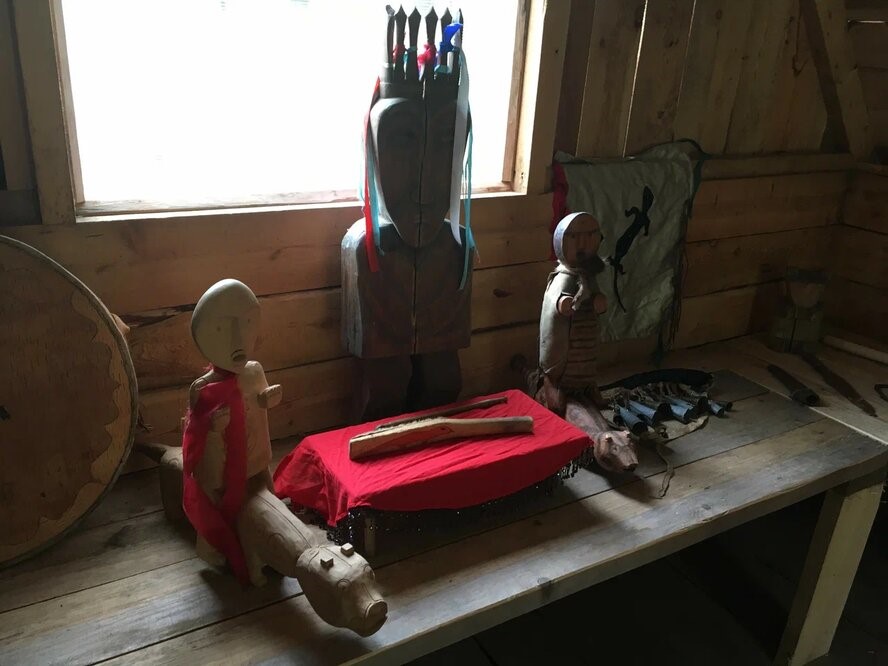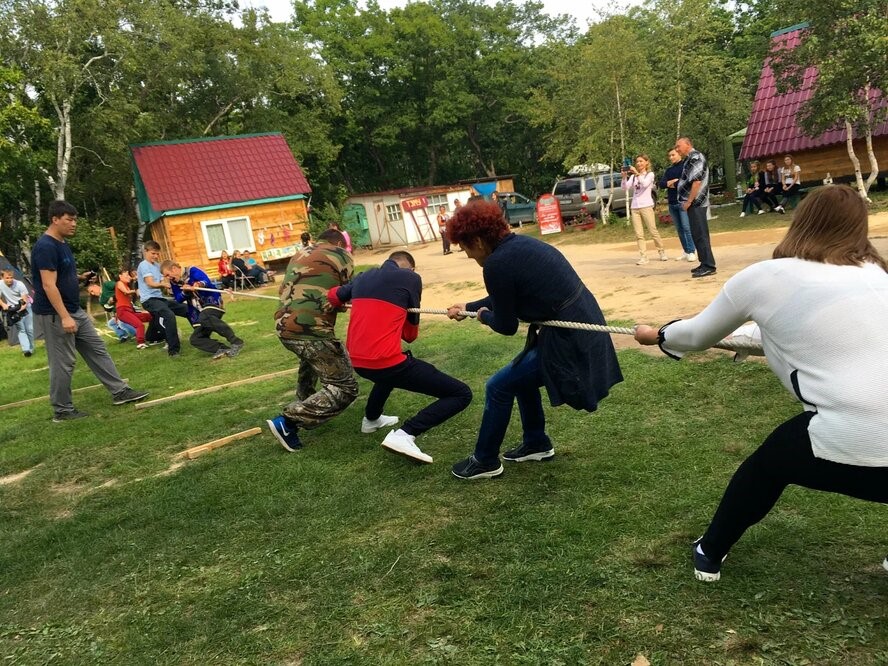|
|
Institute of Ethnology and Anthropology, Russian Academy of Sciences
Oksana Zvidennaya
|
The Taz. Spiritual Culture: Mythologies, Traditional Beliefs, Holidays and Rituals
The Taz’s concepts of soul and nature are based on animism. They understand nature as everything that surrounds a human being: the sky, mountains, rivers, the taiga, the elements, the earth, including spirits and deities. Everything is governed by good and evil spirits. Their hosts inhabit the world around people and, taking advantage of their invisibility, they watch over human beings. The Taz believe that every animal species has their master equal to a forest deity.
The Taz believed the world of spirits to be divided into the good
syns
and the evil
sakkhas
; that set the Taz’s beliefs apart from those of the Udege who did not envision such a division. An invisible entity, the supreme deity called
Lao-e
ruled all the heavenly and earthly deities and good and evil spirits. His power does not extend only to
Yangu-e
, an equally powerful deity of the underworld, and to
Yaudin
, the god of evil who sends diseases.

Many aspects of the Taz’s spiritual culture are close to Chinese spiritual traditions. Those Chinese who follow Taoism and Buddhism believe in different worlds and the many deities that inhabit the world. The Taz divided the universe into three worlds: the heavenly world, the earthly world, and the underworld. The Taz called the upper (heavenly) world
tyakho
, it was governed by the deity
Lao-e
. The middle, or earthly, world,
yandy
, was associated with the taiga, the place of living, hunting, and fishing; it was governed by the deity
San-Syn-e
(
San-sy
) whose closest helper was the tiger
lomaza
. The lower world, or the underworld,
indya
, was ruled by the deity
Yangu-e
. (Sem2004: 932). Each deity of a particular world has many helpers, local
ezens
, masters of living being and natural objects.

The shaman
teda syn
(
dy
) acted as an intermediary between deities of the universe and masters of specific lands; the shaman guided souls to the underworld by performing special rituals. Today, theTazdonotpracticeshamanism.
The Taz carry out communication with supreme deities, spirits of trees, the earth, roads, or ancestor spirits via rituals with shrines showing the images of deities. Most frequently, they depicted the supreme god
Lao-e
;
Shen-ny-shi
, the god who held in his possession all the means of healing;
Lue-wan
, the god of rain;
Mao-wan
, the god of horses;
Shan-Zhen
, the god of wealth;
Hui-dzy
, the god of war;
Thu-dy
, the god of tilling; and
Yaudin
, the god of evil. Shrines served as sites for worship rituals and for making ritual offerings.
The shrines were of three kinds: public (
laoinfu
), family (
lao-e-myao
or
myoo
), and hunting (
lao-patu
) shrines. Theydifferedinsize, shape, andpurpose. Public shrines could be found in every Taz village, in forests, on top of mountain passes. Family shrines
lao-e-myao
or
myoo
were built a hundred paces from the fanza, in fields or vegetable gardens, closer to the taiga, in secret places around a homestead’s yard. Hunting
lao-patu
shrines were built on noticeable trees, on top of hills or on those mountain passes where were believed by Taz hunters to have been chosen by tree spirits and master spirits as places to rest in.
The most important rituals were performed by the maternal grandfather called
Lao-
e in Taz kinship terms, just like the supreme deity.
Every house mandatorily had images of the most worshipped gods, the house god and the master of fire. The image of the
loyfu
house god was in every home shrine. The Taz hung it across from the entrance, at the place of honor. It was mandatorily accompanied by the master of the universe
Lao-e
, the master of the door
Man-hue
, and the god of fire
Tso-hue
.
The Taz devote special attention to the master of fire known among the natives of the Amur region as
puza
(
pudya, podya
) for they believed that human well-being depended on him. People share food with him throwing best pieces into the fire; he was also “treated” to alcohol, asked for help in hunting. He was also celebrated in thanksgiving rituals. The Taz treat
puza
with care. According to them, people must never offend fire, stab it with a knife or sprinkle it with water. When spending the night in the taiga, people could not put their heads of one end of a log if the other end was in the fire; such a log could not hacked with an axe or cut with a knife; branches or meat could not be cleaved on such a log, nor could fish be cleaned. Playing with cinders in a fire was prohibited as was poking coals with a stick. The Taz believe that those who break this taboo might be punished by diseases.
The Taz believed
San-syn-e
to be the master of hills, forests, and mountains;
San-syn-e
had the tiger
lomaza
for his helper; the tiger was associated with ancestor spirit, just like the brown bear
koutoza
. The deity granted luck in hunting and in searching for ginseng (Sem 2004: 932). Tiger and bear worship evidence the Taz’s diverse ethnic cultural contacts.
The Taz believed mountain tops to be sacred. They also believed in masters of the mountains who owned animals and had control of their fate. The mountain worship is an ancient tradition. The Taz still believe snowed mountains to be the dwelling places of the spirits of their mythical ancestors.
The Taz’s funeral rites also manifested their beliefs. The Taz believed their dead relative souls to have a connection with and influence of the life of their living relations. The Taz believed the
inde
underworld to be like the earthly world: it had forests, rivers, mountains, villages, dwellings. People were believed to move from the temporal earthly world to the
inde
world to live there permanently. Prior to passing on to that world, people had to prepare for it during their lifetime, and there were several rituals for it including getting the funeral clothes
sy in ykhe
ready; it had to be always at the ready; they also had a stomach purging ritual so that nothing would connect the dead person with the earthly life.

Today’s Taz have some vestiges of the traditional rites: asking for luck in hunting and fishing from the master and mistress of fire; sprinkling vodka into the fire or into the directions of the compass during holidays, etc.
Showcase holiday riles imitating shamanic rituals and held by fire are gaining popularity. Everyethnically-coloredeventfeaturessucharite. Shamanicperformancesopenpubliceventsandindigenouspeoples’ festivals.
The Taz’s family and public holidays were connected with the annual cycle and dedicated to forces of nature that were in charge of prosperity and luck. Family holidays included the
tkhyan syo hai
celebration connected to the birth of a child. It was celebrated a month after a child was born and the young mother moved into the house. The
chin min
day for remembering the dead is marked in March: people go to family cemeteries, spill grain on graves, burn paper money, tell the dead about how things are going with them, and ask for help in their affairs or ask not to disturb the living. Family holidays also include
kue se
in honor of the spirit of fire. It is celebrated a week before the New Year with the entire family assembling around the family hearth.
The holiday celebrated on the largest scale in the annual cycle is the New Year
konyan
. It was celebrated for two weeks in the end of January. The Taz never worked during this time period. They cooked a large variety of dishes and in large quantities, meat dishes and drinks in particular. People came over to visit each other, danced, fired their guns, and played board games such as chess, dice, cards, and dominoes. They held horse races
sima nyan tkha
,
suai dyo
Taz martial art competitions, played tug-of-war with sticks called
tsoi kunza
. Men and women celebrated this holiday separately.

The
seu
holiday was celebrated 15 days after the New Year and it completed the New Year celebrations. During that holiday, neighbors walked the streets and smeared each other with soot.
The start of the field-working season was marked in March with the
sayue slyu godiye
holiday (“Welcoming spring”).
Ue tie
, “Welcoming summer,” a holiday similar to the Russian Trinity holiday, was celebrated in summer. Plantswerebelievedtohavethepowertocurepeoplethatday. So early in the morning, before sunrise, men would go into the forest, break branches off different trees (birch and oak), would bring herbs and hang them around the house under the roof where they hang until they dried, and then the celebrations would start.
The end of harvesting season was marked with the Fall or Harvesting holiday
pandie (payade) godiye
. This popular holiday was celebrated over two days, from August 15 to August 17. No fewer than eight ethnic dishes were made for the celebration, people were served many different vegetables, fruits, root vegetables, nuts, and other treats. The peak of the celebration was serving a watermelon cut in a zigzag.
The Winter holiday
tunkya godiye
was the last one in the annual cycle celebrated by the Taz in December. Itcoincidedwiththestartofwinterhunting.

Today, the Taz celebrate secular holidays, first the all-Soviet ones and then the all-Russian ones. The
Temu
Center for Preserving and Developing the Traditional Way of Life, Economy, Hunting, and Fishing of Indigenous Peoples in the Olga district holds the annual
Sagdi Dava
(The Great Siberian Salmon) holiday celebrated by everyone including the Taz. The holiday always features ethnic dishes, Siberian Salmon soup, singing and dancing, and the performance of a rite dedicated to hunting and fishing.



























































